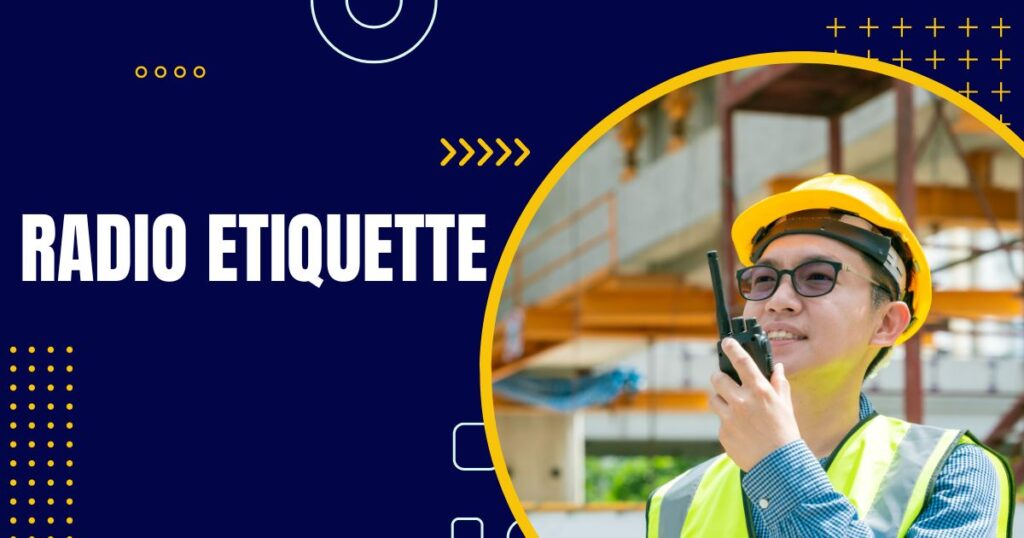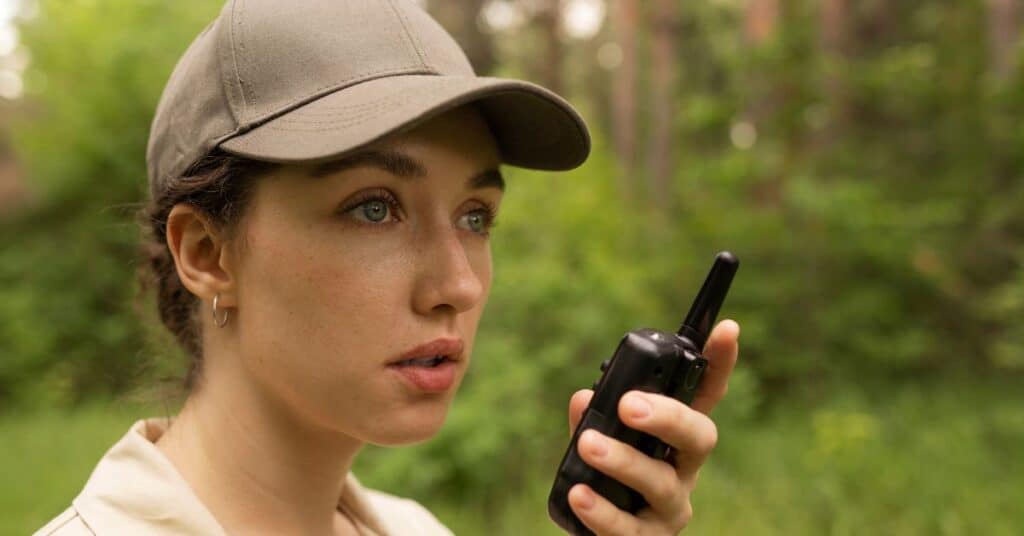When we use walkie-talkies, we’re not just having casual conversations like we do on our phones. Each word we say is like a piece of a puzzle, fitting together to convey important messages clearly and quickly. Radio etiquette is about keeping the conversation efficient and effective. In this article, we’ll learn about what is radio lingo, and how you use it to make your conversation to the point and avoid interruptions.

Contents
Basic Radio Etiquette Guidelines
Alright, let’s break down the basics of radio etiquette. Imagine you’re on a mission, and your walkie talkie is your lifeline. Here’s how to use it.
Concept of Radio Etiquette:
Think of radio etiquette as the golden rule for talking on the airwaves. It’s like having a set of guidelines to make sure everyone can hear and understand each other. Just like being polite when you’re talking to someone in person, radio etiquette helps us communicate clearly and respectfully.
Explanation of key etiquette principles:
- Proper identification when initiating communication:
- When you start talking, introduce yourself and who you’re talking to. It’s like saying, “Hey, it’s me, and I’m talking to you!”
- When talking on the radio, you would say something like, “This is [your name or call sign] calling [the recipient’s name or call sign]. Over.”
- Use of (over) and (out) appropriately:
- (Over) means you’re done speaking but you’re waiting for a reply. It’s like saying, (I’m done, now it’s your turn.)
- (Out) means you’re finished with the conversation and don’t expect a response. It’s like saying, (I’m done talking, goodbye.)
- Using these words helps everyone know when it’s their turn to talk and when the conversation is over.
- Avoiding unnecessary transmissions:
- The airwaves are like a busy street. You don’t want to add more traffic than necessary. Before you speak, think if what you’re saying is really important.
- Don’t repeat stuff unless you have to. It’s like avoiding unnecessary honking on the road. It just annoys everyone.
Common Terms Used in Radio Language
| Radio Term | Meaning |
| Mayday | Distress call, indicating immediate help is needed |
| Roger | Acknowledgment that a message has been received |
| Over | Indicates the end of a transmission |
| Out | Indicates the end of a conversation |
| Copy | Indicates understanding of a message |
| Break | Indicates a pause in transmission for an urgent message |
| Ten-Four | Affirmative, acknowledgment |
| Negative | Indicates disagreement or a negative response |
| Standby | Hold on, wait for further instructions |
| Emergency Traffic | Priority message related to an emergency |
| Squelch | When there is no signal, the audio is muted |
| Frequency | The number of cycles per second of a radio wave |
| Channel | A specific frequency assigned for communication |
| Call Sign | Unique identifier for a radio station or operator |
| Transmission | The act of sending a message over the airwaves |
| Reception | The act of receiving a message over the airwaves |
| Static | Interference or noise disrupting radio transmission |
| Signal Strength | Measure of the intensity of a radio signal |
| Relay | Passing a message from one station to another |
| Check-In | Reporting your presence on a radio network |
| Dead Air | Period of silence on a radio channel |
| Net Control | Station responsible for coordinating a radio network |
| Mayday Relay | Transmitting a distress call on behalf of someone else |
What Are Phonetic Letters?
When you’re using walkie talkies, sometimes it’s hard to hear certain letters clearly because of static or noise. Phonetic alphabets are useful for this! Instead of saying just (A) or (B), we use special words that represent each letter.
Here is a list of Phonetic Alphabet from A to Z:
| Letter | Phonetic Word | Letter | Phonetic Word | Letter | Phonetic Word |
|---|---|---|---|---|---|
| A | Alpha | J | Juliet | S | Sierra |
| B | Bravo | K | Kilo | T | Tango |
| C | Charlie | L | Lima | U | Uniform |
| D | Delta | M | Mike | V | Victor |
| E | Echo | N | November | W | Whiskey |
| F | Foxtrot | O | Oscar | X | X-ray |
| G | Golf | P | Papa | Y | Yankee |
| H | Hotel | Q | Quebec | Z | Zulu |
| I | India | R | Romeo |

Why We Use Radio Etiquette
Clarity and Understanding:
Ever been in a noisy room where everyone’s talking at once? Radio etiquette is like turning down the noise so we can understand each other better. It helps make sure our messages are clear and easy to get, using the right words and keeping them short and sweet.
Efficiency:
Think of radio etiquette like using emojis instead of writing long sentences when you text. It’s faster and gets the point across without wasting time. By using (over) and (out) in the right places, we keep the conversation flowing smoothly and avoid talking over each other.
Respect for Others:
Do you know how annoying it is when someone interrupts you mid-sentence? Radio etiquette helps us show respect to others using the same frequencies. It’s like taking turns on the swing set – everyone gets a chance to talk without getting pushed aside.
Safety:
Picture this: you’re out hiking with friends, and suddenly someone gets hurt. Using radio etiquette means we can quickly call for help and make sure the message gets through loud and clear. It’s like having a lifeline when things go south.
Legal and Regulatory Compliance:
Ever played a game with rules? Radio etiquette is like following the rules of the game. There are laws and regulations about how we use radios, and sticking to etiquette helps us play by the rules and stay out of trouble.
Tips for Clear and Effective Conversations
Speak Clearly and Concisely:
When you’re using a radio, make sure to speak clearly and with confidence. Avoid speaking too quickly, as it can make your message hard to understand. Take a breath, articulate your words, and be concise in what you say.
Know Your Equipment:
Take some time to familiarize yourself with the radio equipment you’re using. Learn how to adjust the volume, switch channels, and use any additional features it may have. Understanding your equipment will help you use it effectively in different situations.
Practice Active Listening:
Pay attention to what others are saying on the radio before you speak. Active listening means focusing on the conversation and responding appropriately. Wait for a break in the conversation before you transmit your message.
Use Standard Terminology:
Get familiar with the standard terms and phrases used in radio communication. Terms like (Roger that) (copy that,) and (10-4) are commonly used and help keep communication clear and efficient.
Maintain Professionalism:
Whether you’re using the radio for work or fun, always maintain a professional tone. Avoid using slang or inappropriate language that could be misunderstood or make you sound unprofessional.
Be Brief and to the Point:
Keep your messages short and to the point. Nobody wants to hear a long-winded explanation over the radio. Get your message across quickly and clearly, and then let others respond.
Listen Before Transmitting:
Before you transmit your message, take a moment to listen to what’s happening on the radio. This helps you avoid interrupting someone else’s conversation and ensures your message is relevant to the current situation.
Follow Radio Etiquette:
Learn the proper etiquette for using a radio. Use phrases like (over) to indicate you’re done speaking and (out) to signify the end of your transmission. Following these guidelines keeps communication smooth and respectful.
Be Patient and Respectful:
Sometimes radio communication can be frustrating, especially if there’s a lot of noise or interference. Show respect to others on the radio by giving them the opportunity to communicate without interruption.
Review and Reflect:
After using the radio, take a moment to think about how it went. Did you communicate effectively? Were there things you could improve on? Reflecting on your radio communication skills will help you get better over time.
What do (Roger that, Copy that, and 10-4) Mean?
Roger that:
When someone says (Roger) or (Roger that) on the radio, it means they got the message and understand what was said. It’s like saying (I heard you and I understand) in a radio talk. The word (Roger) comes from the military alphabet, where (R) stands for “Received.”
Copy that:
(Copy that) is another way of saying (I understand) on the radio. It’s like saying (Got it) or (Message received) The word (copy) is used to show that the message was received and understood without needing any more explanation.
10-4:
This is a special code used in radio communication to say (yes) or (I agree) It’s part of a system called ten codes used by emergency services and police. When someone says (10-4) it means they heard the message and agree with it. It’s a quick way to say (I understand) without using a lot of words.
Conclusion
In the world of walkie-talkies and radios, using the right words is like putting together pieces of a puzzle to share important messages clearly and quickly. Radio etiquette helps us talk effectively by following rules that make sure everyone understands each other. We introduce ourselves, use words like “over” and “out” correctly, and avoid talking too much. Radio terms like “Roger” and “Mayday” help us communicate better, especially in emergencies. Learning radio etiquette is like learning to be a good friend on the airwaves – respectful, clear, and ready to help when needed.
